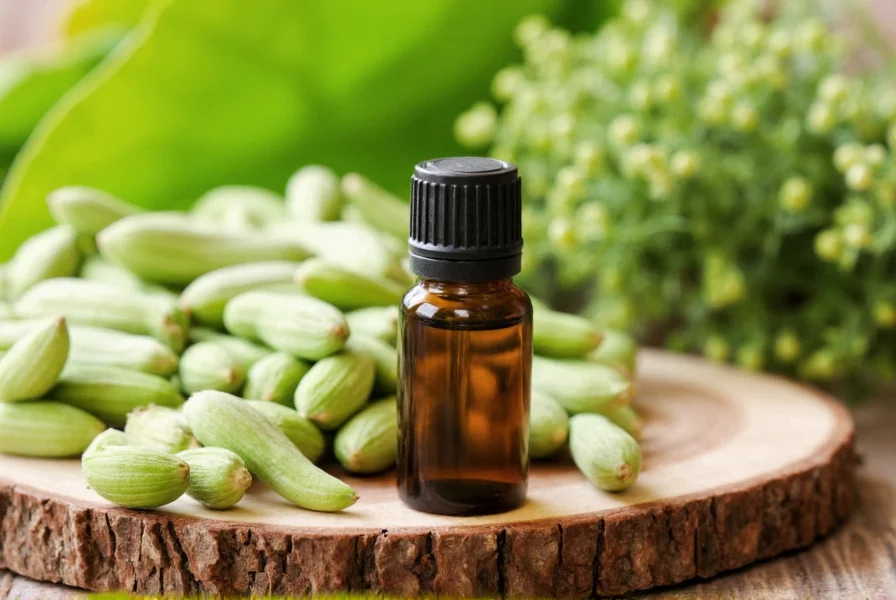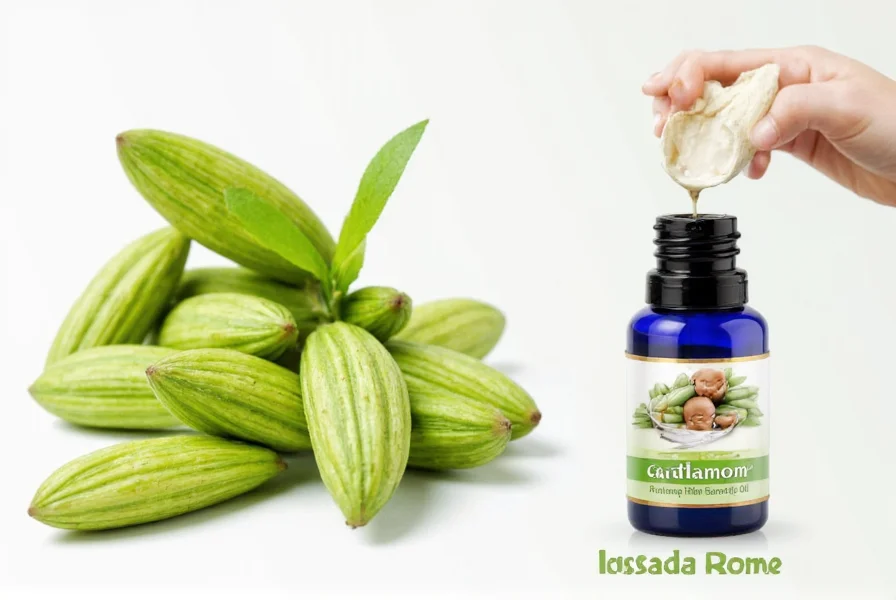Derived from the seeds of the cardamom plant through steam distillation, cardamom essential oil has been valued across cultures for centuries. This potent extract contains bioactive compounds like 1,8-cineole, α-terpinyl acetate, and limonene that contribute to its distinctive aroma and potential therapeutic properties. Understanding proper usage and realistic expectations is crucial when incorporating this oil into wellness routines.
What Exactly Is Cardamom Essential Oil?
Cardamom essential oil comes in two primary varieties: green cardamom (Elettaria cardamomum) and black cardamom (Amomum subulatum). Green cardamom oil, with its sweet, floral notes, contains higher concentrations of 1,8-cineole (up to 30%), while black cardamom offers a smokier aroma with different chemical profiles. The extraction process significantly impacts quality—steam distillation preserves delicate compounds better than solvent extraction methods.
Unlike cardamom spice used in cooking, the essential oil is highly concentrated. It takes approximately 200 pounds of cardamom pods to produce just one pound of essential oil, explaining its potency and premium pricing. This concentration means therapeutic applications require careful dilution, typically at 1-2% for topical use.
Traditional Uses and Modern Applications
Historical records show Ayurvedic practitioners using cardamom for digestive issues as early as 300 BCE. Traditional Chinese Medicine incorporated it for "warming the middle burner" and addressing stagnation. These historical applications align with contemporary uses where cardamom essential oil for digestion remains popular, often diffused or applied diluted to the abdomen.
| Traditional Application | Modern Usage Method | Scientific Support Level |
|---|---|---|
| Digestive aid | 1% dilution abdominal massage | Moderate (animal studies) |
| Respiratory support | Inhalation via diffuser | Preliminary (in vitro) |
| Mood enhancement | Aromatherapy diffusion | Limited human studies |
| Oral health | Mouth rinse (highly diluted) | Emerging research |
Evidence-Based Benefits of Cardamom Essential Oil
Recent research provides insight into cardamom essential oil therapeutic properties. A 2022 study in the Journal of Ethnopharmacology demonstrated significant antimicrobial activity against common pathogens like E. coli and S. aureus. The oil's high 1,8-cineole content contributes to its potential respiratory benefits, though most evidence comes from in vitro studies rather than human clinical trials.
For digestive health, animal studies show promising results. Research published in Phytotherapy Research noted reduced gastric lesions in rats treated with cardamom oil, suggesting possible gastroprotective effects. However, human studies remain scarce—most digestive benefits reported anecdotally relate to traditional usage patterns rather than clinical evidence.
The antioxidant capacity of cardamom essential oil warrants attention. A comparative analysis in Food Chemistry found it contains substantial phenolic compounds that may combat oxidative stress. While not as potent as some essential oils like clove, its unique chemical profile offers complementary benefits in holistic approaches.
Safe Usage Guidelines for Cardamom Essential Oil
Proper application ensures safe use of cardamom essential oil. Always perform a patch test before widespread topical application. For adults, dilute to 1-2% in carrier oil (5-10 drops per ounce of carrier). Never apply undiluted to skin—this can cause irritation or sensitization.
When using cardamom essential oil for aromatherapy, limit diffusion sessions to 30-60 minutes with adequate ventilation. Prolonged exposure may trigger headaches in sensitive individuals. Pregnant women should avoid therapeutic use without medical consultation, as cardamom's emmenagogue effects could potentially stimulate uterine activity.
Special caution applies to children and pets. Do not use on children under 6 years old. Keep away from cats entirely, as their livers cannot process certain essential oil compounds. For dogs, consult a veterinarian before use and maintain extremely low concentrations.

Quality Assessment: Choosing Authentic Cardamom Oil
Selecting high-quality pure cardamom essential oil requires careful evaluation. Look for GC/MS (gas chromatography/mass spectrometry) reports verifying chemical composition. Authentic green cardamom oil should contain 20-30% 1,8-cineole and 15-25% α-terpinyl acetate. Prices below $15 per 5ml often indicate adulteration.
Check for proper labeling including botanical name (Elettaria cardamomum), country of origin (Guatemala produces premium quality), and extraction method (steam distilled). Avoid products labeled simply as "fragrance oil"—these contain synthetic compounds without therapeutic properties.
Comparative Analysis With Similar Essential Oils
When considering cardamom essential oil versus other digestive oils, notable differences emerge. While ginger oil provides stronger immediate anti-nausea effects, cardamom offers more balanced digestive support with less potential for heartburn. Compared to peppermint oil (which can exacerbate GERD), cardamom presents a gentler alternative for sensitive individuals.
For respiratory applications, eucalyptus oil contains higher 1,8-cineole concentrations (70-85% versus cardamom's 20-30%), making it more potent for congestion but potentially more irritating. Cardamom's complex aroma profile creates a more pleasant diffusion experience for extended use.

Integrating Cardamom Oil Into Wellness Practices
Effective cardamom essential oil aromatherapy techniques include blending with complementary oils. For digestive support, combine 2 drops cardamom with 1 drop ginger in 1 ounce carrier oil for abdominal massage. Respiratory blends work well with 3 drops cardamom, 2 drops eucalyptus, and 1 drop rosemary in a diffuser.
Mindfulness practitioners report enhanced meditation experiences when diffusing cardamom oil. Its unique scent profile—simultaneously warming and clarifying—creates an ideal atmosphere for focused breathing exercises. Try 2-3 drops in your diffuser 15 minutes before meditation sessions.
For culinary applications (using food-grade oil only), add a single drop to baked goods or chai tea blends. Never ingest standard essential oils not specifically labeled as food-safe—this represents a significant safety risk.
Frequently Asked Questions
Can cardamom essential oil help with nausea?
While limited human studies exist, preliminary research suggests cardamom oil may provide mild anti-nausea effects through its 1,8-cineole content. A 2020 study in Complementary Therapies in Medicine found inhaled cardamom reduced nausea in postoperative patients, though results were less pronounced than with ginger. Always dilute properly and consult your healthcare provider for persistent nausea.
How does cardamom essential oil affect blood pressure?
Current research shows minimal direct impact on blood pressure. A 2021 animal study in the Journal of Cardiovascular Pharmacology noted slight vasodilatory effects at very high concentrations, but these are unlikely with standard aromatherapy use. Individuals with hypertension should monitor their response and consult their physician, especially when combining with blood pressure medications.
Is cardamom essential oil safe for daily use?
When properly diluted (1-2% concentration), cardamom essential oil is generally safe for daily aromatherapy use. However, continuous topical application without breaks may cause skin sensitization. Rotate with other oils and take weekly breaks. Never exceed 30-60 minutes of diffusion per session, and ensure adequate room ventilation between uses.
What distinguishes true cardamom essential oil from adulterated versions?
Authentic cardamom oil has a complex, warm-spicy aroma with citrus undertones. Adulterated versions often smell overly medicinal or one-dimensional. GC/MS reports should show 20-30% 1,8-cineole and 15-25% α-terpinyl acetate. Price is another indicator—genuine cardamom oil costs $30-$50 per 5ml. Avoid products without botanical names or country of origin listed.
Can cardamom essential oil interact with medications?
Potential interactions exist with blood thinners due to cardamom's coumarin content, though levels in essential oil are minimal compared to whole spice. Theoretical interactions could occur with diabetes medications as cardamom may affect blood sugar. Always consult your healthcare provider before using essential oils if taking prescription medications, especially for chronic conditions.











 浙公网安备
33010002000092号
浙公网安备
33010002000092号 浙B2-20120091-4
浙B2-20120091-4